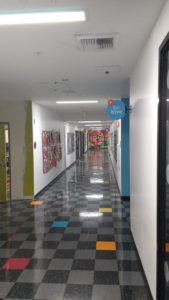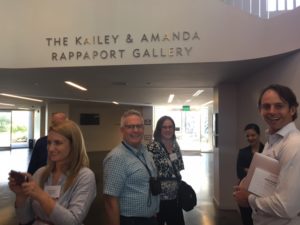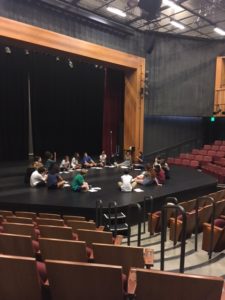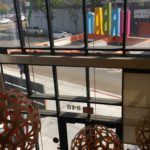Days 4 & 5 of our study tour of future-focused schools took in three very different schools (for details of previous schools visited, see the last blog post).
Our first stop was New Roads School, a K-12 school, in Santa Monica. As the inspirational Principal Luthern Williams explained, New Roads is unique: an independent school entirely committed to social equity. In practice, this means that parents who can afford their fees know that 50% of those fees enable kids from under-privileged areas of Los Angeles to attend. You might think with such a disparity of backgrounds there’d be two distinct sets of students. In reality, it’s impossible to spot which students are on scholarships and which aren’t.
The four ‘pillars’ of New Roads – Social Justice, Environmental Stewardship, Diversity and Academic Excellence – are evident in every conversation, every piece of student work. Being located in Santa Monica they are, as Luthern put it, ‘surrounded by companies that are shaping the modern world’: new media, robotics, games developers and software developers abound, and New Roads makes full use of them.
When you forgo half of your income to ensure you achieve social, ethnic and racial diversity, then it’s not surprising to see that New Roads classrooms are, well, basic. But that doesn’t matter, because our group were consistent with other visitors to New Roads in being moved to tears by what Luthern describes as unashamed idealism. It’s hard to accurately dissect how this school works – the pedagogy that we saw wasn’t anything ground-breaking, but their students are astonishing. Their teachers described them variously as “diversity natives” and “global bridge-builders”, powerful advocates of a private school with a public purpose.
The highlight of our visit was a discussion with student ambassadors in the Steven Spielberg theatre (yes, he sent his kids there). They clearly demonstrated – not for the first time on our tour – that if you give students voice and choice, they will reward freedom with great responsibility. Students are taught, largely, by stage not age, and at high school are offered over sixty electives. In many schools such options might lead to a kind of paralysis of choice, but these students utilise this open curriculum to to allow them to find themselves (in the practical sense). One student praised the curriculum, saying “Here, I can be whoever I want to be” (at this moment that looks likely to be a forensic scientist). Another reflected on the personal responsibility that comes with a student-driven curriculum, saying “ If you’re open about where you’re struggling, or where you’re having difficulties, then help is available, but it’s your job to make the move”.
Luthern Williams shared research that shows that diversity isn’t just good for student’s empathy and compassion – it improves cognition too. This is a school where students are valued as equal members of a learning community, their weekly ‘Town Hall’ meetings often identify social and political issues that students feel strongly about – and then they plan action. So, the day before we arrived, the high school students marched in the streets surrounding the school in support of the US ‘dreamers’. Some students, however, felt uncomfortable, and their right not to take part was supported by their teachers. In a class that I witnessed, students were discussing possible links between violence and video games. Some schools might not want students to be discussing current political issues, but New Roads are explicit in their belief that schools have a key role to play in pursuit of the US founding father’s dream of ‘a more perfect union’. Unashamedly idealistic, New Roads is a brilliant example of how academic excellence can be driven by diversity and that perhaps the key purpose of a school is, to paraphrase Luthern Williams, ‘to give students the tools to make sense of the world on their terms, not ours’. I wish every dispirited teacher who believes that teachers make decisions about students’ learning because ‘they don’t know what they don’t know’ could spend a week in New Roads School.
The following day our group visited two sister schools in the urban heart of San Diego. Set up as a single ‘charter’ entity, the two schools (Urban Discovery Academy at K-8 and Ideate High Academy) represent the application of a start-up culture to the persistent problem of public schooling in the United States. Chris Wakefield, the principal of Ideate, showed us alarming statistics on the disparity of wealth in a city like San Diego. Since their schools only get paid on the days that students attend, the lower attendance rates invariably seen in inner-city schools mean that such schools have progressively been starved of money, and have become ever more socially unequal. In an attempt the halt this decline, charter schools are invited to bring more innovation into public education.
Whatever one thinks of charters (in the UK, their equivalent is academies), they certainly don’t get any favours – there are good and bad examples to be found, but the bad ones don’t last long, with charter renewal coming along every five years. As the name suggests, Ideate High Academy have Design Thinking at the heart of their curriculum and early results (they’re only in their second year) are showing that student’s academic results are promising. However, they have another two years before their building is ready and the temporary premises they’re currently using are challenging to say the least – a recent outbreak of hepatitis A among the homeless community that inhabit the streets surrounding Ideate meant that hand sanitisers were everywhere. It doesn’t take more than a few minutes to see the scale of the challenge facing Chris. However, he only has to see the progress that his sister school, Urban Discovery Academy, has made to have cause for optimism.
 Urban Discovery have come through the growing pains of a start-up, have a brand new building, and a waiting-list of students to confirm that they’re doing something right. The building itself is one of the most colourful I’ve seen, and the students seemed delighted with their new home. The ‘content rich’ dominance in recent years in the US definitely seems to have shifted in many urban charter schools and at UDA the curriculum is part STEAM, part project-based – in many ways a restoration of the liberal arts tradition that served US tertiary education so well. As any tech entrepreneur will tell you, starting-up is the hardest part of any project. New Roads School was also a start-up twenty years ago, and they’re now in a position at the forefront of change. We need more private schools with a public purpose. We also need people like Chris Wakefield with vision, boundless energy, and a determination to get over the challenges of start-up, to show that future-focused schools can meet the need for innovation and social purpose in our schools.
Urban Discovery have come through the growing pains of a start-up, have a brand new building, and a waiting-list of students to confirm that they’re doing something right. The building itself is one of the most colourful I’ve seen, and the students seemed delighted with their new home. The ‘content rich’ dominance in recent years in the US definitely seems to have shifted in many urban charter schools and at UDA the curriculum is part STEAM, part project-based – in many ways a restoration of the liberal arts tradition that served US tertiary education so well. As any tech entrepreneur will tell you, starting-up is the hardest part of any project. New Roads School was also a start-up twenty years ago, and they’re now in a position at the forefront of change. We need more private schools with a public purpose. We also need people like Chris Wakefield with vision, boundless energy, and a determination to get over the challenges of start-up, to show that future-focused schools can meet the need for innovation and social purpose in our schools.
Related Posts
Also published on Medium.
Social tagging: Alt-School > Google > Ideate High Academy > Monte Vista Christian School > New Roads School > Nueva > Project-Based Learning > Urban Discovery Academy






